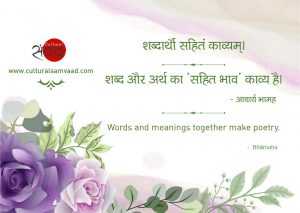Poetry or verse is a universal medium to convey beauty and emotions. The Indian sub-continent especially abounds in songs for every season and every reason. This abundance of verse comes from an unbroken history which can be traced through existing Sanskrit literature.
The Period of Classical Sanskrit Poetry
By definition, the Sanskrit Kāvya (काव्य) or poem involves poems and dramas; the poems further can be in either prose or verse form. Sanskrit literature has a subset known as classical Sanskrit poetry which is distinguished from the much earlier Vedic and related texts. It is generally understood to belong to the vast period between the 2nd century BCE and the 11th century CE. However, the classical period has somewhat fluid boundaries and varies based on context. Sometimes it refers just to the Gupta period. In my opinion, a more apt definition would be the way the poems, stories, dramas are structured and constructed. They mostly follow a set pattern as prescribed in the Nātyaśāstra by Bharata muni. The plays and verses of an earlier era do not conform to the rules laid down in the text.

The classical period is special because it is the one which has given us some of the most enduring plays, stories and poems. Some of the masterpieces that came to life are the poem Meghaduta by Kālidāsa, the novel Kādambari of Baṇabhaṭṭa and the play Abhijñānaśākuntalam by Kālidāsa, to name a few. These are not only still popular in India but have also enjoyed immense study and popularity with western scholars and readers. The period of the Classical Sanskrit literature is also the era and genre which is largely acknowledged to begin with the Rāmāyaṇa as the first poem. (The Mahābhārata is commonly regarded as itihāsa, although it contains both prose and metre.)
How to write and enjoy poetry?
The extensive body of Sanskrit poetic literature has given rise to an advisory science which is useful to the poet as well as the reader. There are guidelines on not only how to write but also on how to enjoy that which is written or heard or seen. Ancient and medieval scholars like Mammaṭa, Ānandavardhana, Daṇḍin, Rājaśekhara, Kṣhemendra, Uvaṭa, Bhāmaha and many more have written extensively and developed their own schools of poetics which are not only literary but also pseudo philosophical.

Definitions have been attempted for a good poet, poetics and even the connoisseur. The Sanskrit word used for a connoisseur is very interesting. The word is ‘sahṛdaya’ (सहृदय), which defines the reader as one who is possessed of intellect and sentiments to sense the shift in subtle emotions and is appreciative of talent. This is the principle which automatically lifts the whole of Sanskrit literature onto a different plane. Though the initial responsibility lies with the poet to present a piece which is worthy of attention, the definition makes it very clear that there is a shared responsibility of the connoisseur as she/he has to make herself/himself capable enough to be able to grasp the meaning of the poem.
Schools of Poetics
The main features of a good Kāvya have been contracted to the following schools:
- अलंकार – Figures of Speech
- गुणरीति – Characteristics and Style
- रससिद्धान्त – Based on the 9 Rasas
- ध्वनि – Suggested sense
- वक्रोक्ति – Stylistic expressions
The different schools of poetics have adopted one of these features as their primary and defining feature while the other features play a secondary role. Thus, all the features together constitute good poetics with each feature appearing in some degree depending on the school studying and interpreting it.

A number of schools came into existence over the centuries but very few survived the propounders. However, this constant endeavor to understand and analyse literature resulted in penmanship of poetry in the Indian subcontinent of a very high level because it was being studied, interpreted and critiqued by a mature audience.
Reading List:
- Studies in the History of Sanskrit Poetics – S.K.De
- History Of Classical Sanskrit Literature – M.Krishnamachariar
- History Of Sanskrit Literature Classical Period – S.N.Dasgupta and S.K.De
- Sanskrit Poetics as a Study of Aesthetic – S.K.De


What a great read! Very insightful Hetal!